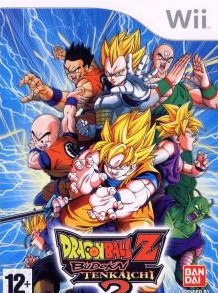Dragon Ball Z Budokai Tenkaichi 2 (Wii) Review
By Ben  18.04.2007
18.04.2007
Dragon Ball Z has been a very popular franchise worldwide for almost twenty years now, and if there's one thing of which it has been very capable, it is selling merchandise. After its transition into videogame form on the original PlayStation in the late nineties, not much has happened to its mechanics apart from its refinement. So why choose this one?
The answer is simple. It is the newest. Although there haven't been many major updates to the original animé and manga, the games have always grown, whether it be through new characters or new storylines, and Spike, the developers, seem to have squeezed every last bit of it out this time around. The content available is simply astonishing, with more than 120 characters available to play with.
The massive amount of playable characters also means that the game is almost guaranteed to be very long lasting, as they aren't all available from the beginning. There is a feature called “Z Item Fusion” that allows you mix and match certain objects, such as “Baby” and “Vegeta”, to create a completely new character – Baby Vegeta. Don't be sucked into how easy it might be to be cynical about the differences between the characters as well, because they all have signature moves that are not found in any other characters as well.
This idea of Fusion also translates over to Transformations too, a key aspect of Dragon Ball's stories. Goku, the main character, can go up to "Super Saiyan Level 3" with the correct conditions in place, and although he is essentially the same "character", he has a vastly improved set of moves at his disposal, as well as the signature yellow glow and hair. All of these little additions, spread across a plethora of individual characters, make for a very deep Dragon Ball experience.
With the game being available on Wii, there is naturally an option to play with the Wii Remote and Nunchuk combination, and whilst cynics could sit around a table and complain all day about the lack of precision offered by the instruments, it is clear that the developers went to a lot of work to make the system as intuitive as possible. Basic hand-to-hand combat is performed with the A button on the Wii Remote, whilst movement is handled with the analog stick on the Nunchuk. Dashing is done with a flick of the Nunchuk, whilst flying (mid battle) is handled with a tilt of the Nunchuk and the C button.
One of the most rewarding things about the game is the gesture-based blast attacks, which are activated after Blast Stock is charged up. For Goku's Kamehameha move, one must put their arms in a position similar to the way it is shown in the cartoon and press both the Z and B buttons. There are a wealth of other options at the player's disposal too, allowing the use of the Classic Controller expansion or a GameCube controller. One of the developers pointed out during the development process that he received complaints from people saying it was "too tiring" to play, so they gave themselves a lifeline by adding this feature. Although the game still plays solidly, it is worth noting that the fun you had playing it with the Wii Remote and Nunchuk is somewhat subdued in this way.
The game's many available modes, including a lengthy Dragon Adventure mode, Dragon Library, Dragon Tournament, Duelling (1P vs 2P), Training, Evolution Z, Data Centre and Item Shop, greatly overshadow some of its more niggling shortcomings, including its bland environmental graphics. Whereas the characters themselves look wonderfully sharp and colourful, the places in which they fight are of not worthy of any special mention. They are destructible and expansive, but surely the developers could have taken the time to improve the textures over the PlayStation 2 version of this game, as Wii is clearly more powerful.
Another complaint is the lack of cohesiveness in the story mode. The narrator will tell you that you must fight a character and "win the battle", but after completing the task, a cut-scene will show that you were brutally defeated and died. This inevitably means that the story modes can be quite boring and repetitive at times, especially if you know what is coming next anyway. The fact that most missions are based on either winning a battle or surviving for a certain amount of time surely demonstrates how much creativity there is to be found in the story mode. Whilst this stays in keeping with the game's aim to tell the whole of the Dragon Ball series from scratch, it makes you wonder if there is ever any point trying to win a battle if you're already destined to "die" afterwards (the answer is that you should, by the way, as progress is not possible until a certain mission is completed). Saying this, with such an extensive list of characters, locales and scenarios to include, Spike has certainly done an admirable job of making it fit at all.
Cubed3 Rating
Great - Silver Award

This game is a must for Dragon Ball Z fans, but if you're just exploring the series, it might be more advisable to just watch the cartoons instead. There isn't much explanation of the characters bar a few short lines, and the modes available can be quite mind-boggling. In the end, all of the assets of the game add up to be a fun if slightly repetitive game.

![]() 8/10
8/10
![]() 8/10
(22 Votes)
8/10
(22 Votes)
 Out now
Out now  Out now
Out now  Out now
Out now  Out now
Out now Comments
Comments are currently disabled

 Sign In
Sign In Game Details
Game Details Subscribe to this topic
Subscribe to this topic Features
Features





 Top
Top

